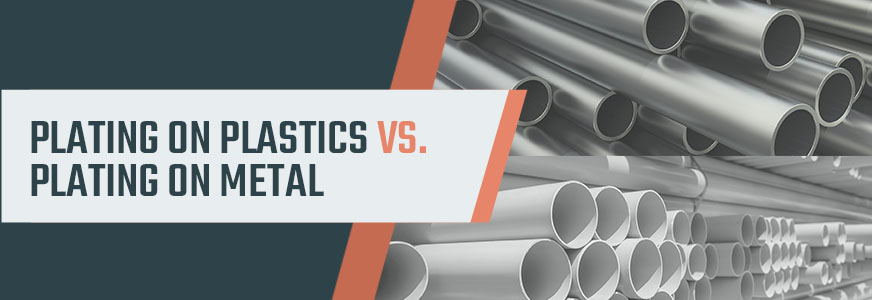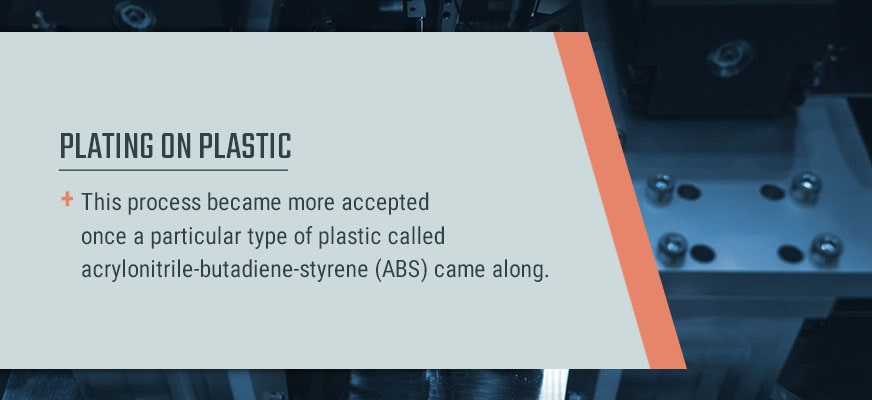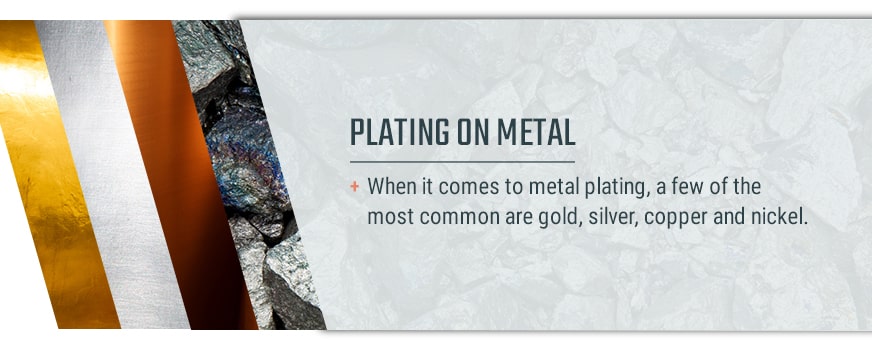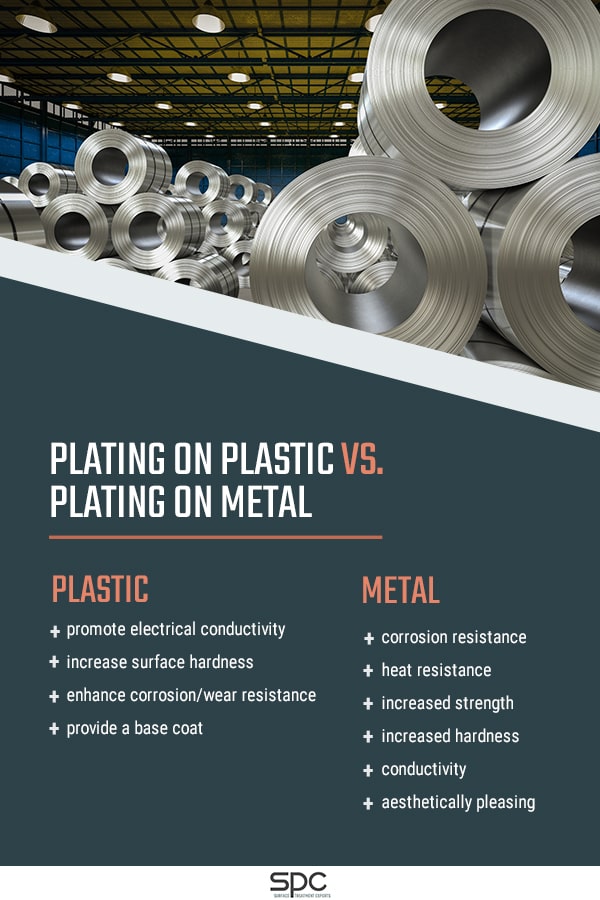Plating is the process of joining metal with a conductive surface. This might make you think of the process of jewelry making. Adding silver or gold plating to a piece of jewelry can make it more attractive.
While plating is a common practice in jewelry making, it is also used in other ways and for other purposes. For example, there are different electroplating methods and electroless plating methods. Within these categories, there are sub-methods, such as rack electroplating and barrel.
To best help our clients with their endeavors, Sharretts Plating Company (SPC) wants to dive into plating onto plastic and plating on metal.
Plating onto Plastic
If the definition at the beginning stuck with you, you might be thinking “but plastic isn’t a conductive surface.” And while you are correct, you can still successfully use plastic plating.
Plating onto plastic originates back to the 1960s. People doubted this process at first, as it took a lot of work and determination to make it function as it needed to. However, this process became more accepted once a particular type of plastic called acrylonitrile-butadiene-styrene (ABS) came along.
The automotive industry was the first to plate onto plastic, but into the 1970s and 1980s, it was used in industries, such as the plumbing industry and the electronics industry.
Roughly 90% of plating onto plastic operations still use ABS, but there are several others that you can use as well. These plastics are divided into thermoplastics and thermosets, two types of polymers with very different properties. Thermoplastics can be heated and reshaped multiple times since no chemical bonding occurs during the curing process. The benefits include its recyclability and resistance to chemicals. However, thermoplastics will melt at a certain temperature, which could be an issue during plating. Thermoplastics include:
- Acrylic
- ABS
- Nylon
- Polylactic acid
- Polycarbonate
- Polyethersulfone
- Polyphenylene oxide
- Polypropylene
- Polyvinyl chloride
- Teflon
In contrast, thermosetting plastics form an irreversible chemical bond after curing. Even with the application of very high heat, thermosets will not melt. This condition makes thermosets ideal for situations where they need to withstand high temperatures and deformation. Thermosets provide the benefits of thermoplastics with additional structural strength and heat resistance. These qualities make them more suited to plating than most thermoplastics. Generally, a resin’s greater resistance to chemicals makes it more difficult to plate. Examples of thermosets are:
- Epoxy
- Furan resin
- Polyester
- Polyhexahydrotriazine
- Silicone
- Urea-formaldehyde
- Bakelite
- Novolak
- Melamine resin
- Polyester resin
Common Metals Used in Plastic Plating
It is common to use metals as a plate on other plastic surfaces. This is especially helpful in applications that need electrical conductivity. Many industries also use metal plating on plastic to add color, aesthetic appeal, strength and corrosion resistance. In some instances, multiple layers of metal may be used.
- Gold: We like to tell our clients that if you can take on the expense of gold, you should heavily consider using this in your plating process. This precious metal offers high resistance to corrosion and tarnishing. Gold plating is also bondable and versatile.
- Nickel: Nickel plating provides great wear resistance and hardness. Nickel is used in automotive applications because its plating process is less toxic than that used for chrome.
- Copper: One of the most popular choices for metalizing non-conductive plastic surfaces is copper, which has high conductivity and a relatively low cost. It is used in many applications.
Many applications also use refractory metals, which are a category of materials with extraordinarily high resistance to heat and corrosion. These metals are conductive and have remarkably high melting points. Refractory metals include:
- Tungsten: Used in many applications requiring high heat resistance, like aerospace and engine systems, tungsten is extremely dense. It is often added to stainless steel to increase its strength.
- Molybdenum: A refractory metal with chemical properties similar to tungsten, molybdenum is resistant to heat and oxidation and has excellent conductivity. Molybdenum is used in a variety of applications, including avionics, glassmaking and manufacturing semiconductors.
- Chromium: Chromium is the element used in chrome plating. Hexavalent chromium is a carcinogen, yet it is still used in the automotive industry to add corrosion resistance and aesthetic appeal to automobiles.
- Titanium: Although not technically one of the main refractory metals, titanium has similar high corrosion resistance and melting point. Titanium combines dependable strength with light weight, making it popular in manufacturing.
Benefits of Plating onto Plastic
There are coatings you can add to your plastic to enhance it. For example, you can add a gold or silver coating. This type of coating can help protect the plastic against corrosion and maybe strengthen your plastic. There’s also a coating you can add that can help protect the plastic against certain chemicals. Depending on what you’re using it for, there are several different chemicals you may expose it to.
Challenges of Plating onto Plastic
With a list of pros always comes a list of cons. Plastic plating is no exception. There are some challenges when it comes to working with plastic.
- Inadequate adhesion
- Scratches and dents
- Warping
- Roughness
- Splay, which refers to breaks or marks on the plated part
- Flash, which refers to a piece of plastic that protrudes from the edge
- Blisters
- Dry down, which refers to physical imperfection
- Skip plate, which refers to when plating doesn’t adhere to certain parts of the plastic
- Burn, which causes the plating to be dark and flaky
Plastic Plating Process
Here are the basics of the plastic plating process.
- Clean: Make sure you clean all materials to remove any dust or debris.
- Pre-dip: Dip the plastic parts into a solvent. This can improve your surfaces and make the process easier in later steps.
- Etching: This can make it easier for the part to absorb liquids and help with bonding with the metal.
- Conditioning: This step is optional. If you choose to do this step, it can help promote better absorption later on.
- Neutralizing: Rinse the product and apply a neutralizer to ensure that you’ve removed any excess products.
- Pre-activation: This will help facilitate absorption. Be careful if you choose to do the conditioning step, as you don’t want to over-condition.
- Activation: Introduce a low-concentrate metal liquid, which will catalyze while plating.
- Acceleration: This will remove excess hydroxide from the part.
- Bath immersion: Place the parts into an electroless bath to create a thin metal coating.
Plating on Metal
When it comes to metal plating, like plastic, you can use several different types of metals, such as:
- Gold: Gold plating is highly conductive, making it an excellent choice for use in semiconductors, printed and etched circuits and other connectors. Gold is the least reactive among metals, which enhances the ability to resist corrosion. It has a natural ability to conduct electricity, which means this might be a better option if you’re plating for electronics. It is essential to note that there are two different types of gold plating: hard and soft. You can typically figure out which you should use by breaking down the project.
- Silver: Silver plating has been around for hundreds of years and is used in many applications. Silver has low corrosion resistance but is also the most conductive metal known today, and is fairly affordable. Silver is often used in electronics, solar and battery power and bearings.
- Copper: Copper is highly conductive and can function as a heat stop-off treatment. It is used in many applications, including printed circuits, semiconductors and electroforming.
- Nickel (Electrolytic): Nickel is especially durable when combined with tin, tungsten or diamond composites. The material offers excellent hardness, wear resistance and conductivity. Nickel can be evenly distributed at your desired thickness.
- Nickel (Electroless): Electroless nickel plating offers a magnetic, bright finish that is extremely durable. It is often used in automotive applications, as it provides greater corrosion protection than chrome and electrolytic nickel plating.
Other kinds of metals on which you can plate are known as Platinum Group Metals (PGM). These metals include:
- Platinum: With chemical inactivity, platinum is popular in a variety of industries, including automotive, oil and gas energy and medical.
- Rhodium: Rhodium is classified as a precious metal and used in telecommunications, electronics and jewelry making.
- Palladium: With its corrosion resistance that is comparable to gold and lighter weight, palladium is most often used in catalytic converters.
- Ruthenium: Ruthenium is often alloyed with either platinum or palladium, as it gives them greater strength. This metal is valuable in electronics and solar technology applications.
Metal Plating Process
The metal and plastic plating processes require similar steps. However, some essential differences set the two apart. For example, plating on plastic is more difficult than plating on metal because of surface differences. Plating onto plastic also takes three to four times as long. In addition, the plastic plating process uses chemistry that is environmentally sensitive.
- Cleaning: As with plating on plastic, the cleaning step should remove all traces of dirt or debris from the material’s surface.
- Rinsing: This step in the process removes dried films and ensures that the metal is uncontaminated.
- Etching: Etching involves dripping acidic solution onto the surface material to increase its ability to absorb the plating. The process produces microscopic holes that facilitate bonding.
- Activation: After etching, a precious metal activator is introduced onto the surface, providing a catalyst for plating.
- Plating: Several methods are used for plating onto metal. In rack electroplating, all the parts that need plating are grouped together, saving costs on plating them separately. Barrel electroplating also plates multiple parts at once by submerging them in a barrel filled with the plating material. The last method of plating is called electroless plating, which avoids using an electrical power source to deposit nickel onto the surface.
Challenges With Plating on Metal
While plating onto metal is easier than plating on plastic, it still comes with some challenges. If you want to plate with metal, consider the following possibilities:
- Pitting, which is the formation of small holes on the surface of the metal, usually caused by inefficient preparation
- Cold shuts, which occur when the metal cools at different stages, leaving flow marks
- Cleavage points
- Unclean manufacturing
- Loss of adhesion, caused by an inadequately prepared surface
- Hydrogen cracking, resulting from hydrogen that makes its way into the part and embrittling the metal
- Hazy, dull deposits, which chemical imbalance, incorrect temperature and contamination can cause
- Blistering
- Oxidation, which leads to poor adhesion
Most defects in metal plating are caused by improper cleaning and preparation of the material before plating, although some are caused by the post-plating cleaning process. These are common issues that can wreak havoc on any part. To protect your parts, it is essential that your plating is completed by a company with a high level of experience, attention to detail and understanding of your application.
Plating onto Plastic vs. Plating on Metal
You’re probably wondering if plating on plastic or metal is better. As with everything, choosing plastic or metal for your plating projects depends on your specific project and the final product’s use. Whether using plastic or metal, there are always pros and cons for each.
Plastic
Let’s first take a look at the benefits of using plastic. Plastic can:
- promote electrical conductivity.
- increase surface hardness.
- enhance corrosion/wear resistance.
- provide a base coat.
There are also some challenges when it comes to working with plastic. One of the biggest challenges is that you have to be very careful which plastics you use. You can use some plastics in a modified form, but that requires extra steps to prepare the plastic for plating. The process of plating onto plastic also requires several additional steps in the pre-plating phase of the work.
Metal
Like plastic, metal plating has some benefits, such as:
- corrosion resistance
- heat resistance
- increased strength
- increased hardness
- conductivity
- aesthetically pleasing
As you can see, there are a few similarities between the benefits of plating on metal and plastic.
As always, there are some challenges when it comes to metal plating, such as that the metal can begin to tarnish over time. In addition, plating may lead to sharper edges, which can lead to uneven coating. Other kinds of defects can also occur if careful attention is not paid to avoid pitfalls, including cold shuts, cracking and oxidation.
When it comes to plating onto plastic or plating on metal, each material has benefits and challenges that come along with it. The best way to decide between one material or the other isn’t to analyze a pros and cons list. Instead, you should analyze your project. You’ll want to find the best plating material and method for you and your product.
How Can SPC Help?
We’ve outlined some of the different methods we are familiar with, but we also have expertise with certain industries. Different industries have different needs and purposes for plating, so someone helping must be familiar with the different plating processes. Otherwise, you might end up with a process that doesn’t perform as it needs to in the environment you’re in. We have some experience working with the following fields:
- Aerospace
- Electronics
- Defense
- Automotive
- Medical
- Oil/Gas
- Optics
- Power generation
- Semiconductors
We can also help when it comes to troubleshooting your problems. SPC can efficiently find the problem and come up with a solution. We pride ourselves on providing a permanent fix to the problem rather than just a temporary solution.
Additionally, we can offer samples before you finish your work. For example, if you can show us what we’re working with, we can find similar materials used with our techniques to show you what an end result might look like.
Contact SPC for Help With All Things Plating
Now that you know the main differences between plating on metal and plastic, you’ll be better prepared to pick the perfect plating material for your next project. Plastic might be your ideal choice if you want to promote electrical conductivity and enhance your project’s corrosion resistance. In contrast, when you want an aesthetically pleasing and harder surface, you might want to go with a metal, like silver or gold.
Even if you’re still unsure about the best plating material for your project, SPC can help. When you turn to us for your plating needs, we’ll take a look at your project and help you determine which plating method is best for you. As you’ve seen, there are so many different options, and the material you use heavily depends on your specific product and its intended use.
We aren’t going to push the most expensive option or the option that works most of the time. We will work with you to find what will work best for you and your project needs, whichever route that may be.
If you’re interested, you can contact SPC through our website or call us at (717) 767-6702 to get your free quote today.








